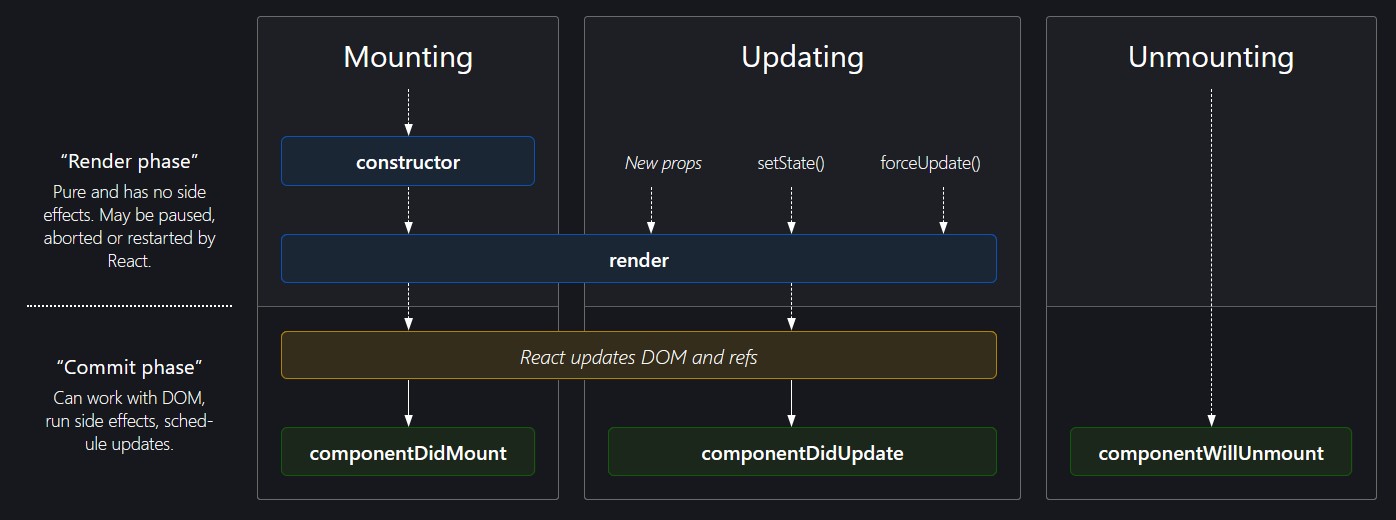React Cheatsheet
Table Of Contents
Design Patterns
A common React programming pattern is to use a parent stateful component to manage state and define state updating methods. Then, it will render stateless child components. One or more of those child components will be responsible for updating the parent state (via methods passed as props). One or more of those child components will be responsible for displaying that state.
Here is a snippet code that Menu.js is a stateless component and will update the state of its parent component.
class App extends React.Component {
constructor(props) {
super(props);
this.chooseVideo = this.chooseVideo.bind(this);
}
chooseVideo(newVideo) {
this.setState({
// Change something
});
}
render() {
return (
<div>
<h1>Video Player</h1>
<Menu chooseVideo={this.chooseVideo} />
</div>
);
}
}
class Menu extends React.Component {
constructor(props) {
super(props);
this.handleClick = this.handleClick.bind(this);
}
handleClick(e) {
// The e is an event object
this.props.chooseVideo(e.target.value);
}
render() {
return (
<form onClick={this.handleClick}>
</form>
);
}
}
Component Lifecycle

Precompile
Some tools for a React app
1- Precompile the code with JSX format: npx babel <src> --out-dir <out> --presets react-app/prod
2- Good dependencies:
- babel-cli
- babel-runtime
- babel-preset-react-app = “^3.1.2”
- babel-plugin-transform-runtime
- webpack-cli
- webpack
3- Webpack creates a bundle. Read more
Webpack
Config file with multiple entry points:
const path = require('path');
module.exports = {
entry: {
app: './src/app.js',
search: './src/search.js',
},
output: {
filename: '[name].js',
path: __dirname + '/dist',
},
};
Parallel Multiple Export
In case you export multiple configurations, you can use the parallelism option on the configuration array to specify the maximum number of compilers that will compile in parallel.
module.exports = [
{
//config-1
},
{
//config-2
},
];
module.exports.parallelism = 1;
Loaders
Webpack only understands JavaScript and JSON files. Loaders allow webpack to process other types of files and convert them into valid modules that can be consumed by your application and added to the dependency graph.
- The test property identifies which file or files should be transformed.
- The use property indicates which loader should be used to do the transforming.
const path = require('path');
module.exports = {
output: {
filename: 'my-first-webpack.bundle.js',
},
module: {
rules: [{ test: /\.txt$/, use: 'raw-loader' }],
},
};
Webpack and Tailwindcss
Read this doc
JSX
- Conditional:
&&is commonly used to render an element based on a boolean condition.{condition && <Element />} {condition && <p>A paragraph</p>}
Hooks
How to use hooks with the previous state:
function Counter({ initialCount }) {
const [count, setCount] = useState(initialCount);
return (
<div>
Count: {count}
<button onClick={() => setCount(initialCount)}>Reset</button>
<button onClick={() => setCount((prevCount) => prevCount - 1)}>-</button>
</div>
);
}
Handwrite Notes
- Passing Arguments to Event Handlers
It is common to want to pass an extra parameter to an event handler. For example, if id is the row ID, either of the following would work:
<button onClick={(e) => this.deleteRow(id, e)}>Delete Row</button> <button onClick={this.deleteRow.bind(this, id)}>Delete Row</button> - You should add type module to the script tag in the HTML file
<script defer type="module" src=""></script>